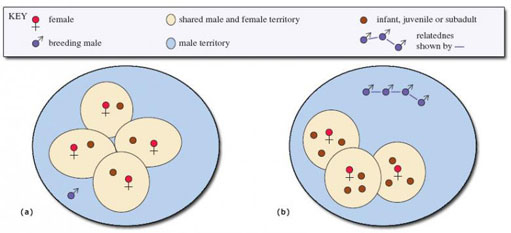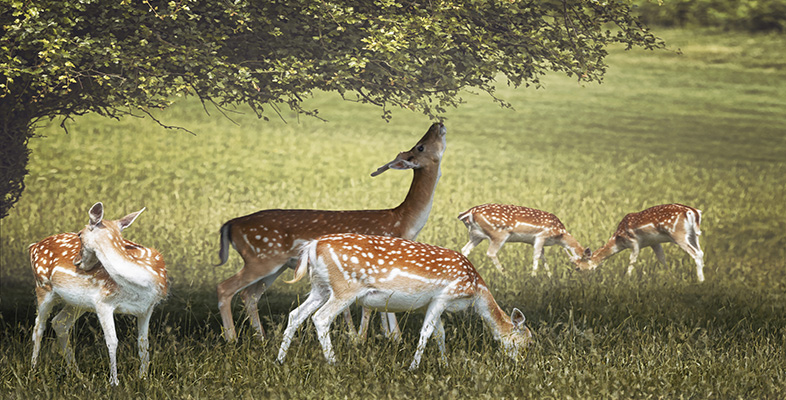2 Variable structure of ape societies
You will be aware from watching the TV programme that information on behaviour and social structure of apes is gathered by many hours of patient observation.
Activity 2
Use your notes from Activity 1, and also LoM Chapter 10, as source material for writing about 200 words on how orangutans obtain their food and how diet and feeding is related to the social structure and way of life of the orangutan.
Discussion
In most areas where they live, orangutans are solitary, and range through their forest territories feeding on tree fruits. A large animal like an orangutan has to find a substantial amount of food each day and it's unusual for there to be enough fruit trees in one area of forest to feed a group. Living in large groups might therefore be difficult, as one adult orangutan might well need sole access to all the trees to obtain sufficient fruit. But orangutans in the swamp forests of northern Sumatra live in large groups, a habit that is linked to the abundant food supply there. The trees in the swamp forest, e.g. Neesia [p. 289], have frequent peaks of fruit production because of the nutrients provided by flood waters. Large groups of orangutans feed together on Neesia, using carefully prepared twigs to remove the irritant hairs from the coat of the fruit. They also collect honey from bees' nests in tree branches by inserting trimmed twigs into the entrance holes. While feeding in groups, the orangutans usually appear to be in harmony - the young play with each other, for example. Disputes between males over opportunities for mating are generally settled by the dominant male in the area.
On this evidence, you might think that orangutans do not have a specific social structure - each individual more or less 'doing their own thing', depending on where he or she lives. In fact, there is a social structure; the core is a single female, who lives with her dependent offspring in a defined home range that overlaps with the ranges of other females. Each solitary male defends a large territory that includes the home ranges of several females with whom he mates. The male, weighing around 90 kg, is about twice the size of the female and defends his territory aggressively against incursion by other males, using his large canine teeth as weapons. The photograph of a male in LoM p. 286 shows the large fleshy cheek pads of orangutans; these can become inflated when vocalising and it is often suggested that this helps increase the volume of their calls, though some experts dispute this. What is certain, however, is that the loud, prolonged bellowing sounds emitted by males advertise their presence to other orangutans. The male mates with the several females that live in his territory, but each female lives alone with her offspring for most of the time. This social structure is termed 'exploded' unimale, which means that one male defends a harem of females scattered over a wide area. Figure 2a shows the arrangement in diagrammatic form. However, the recent discoveries in the forests of northern Sumatra referred to above have shown that orangutans do live in more coherent groups when huge quantities of fruit are available.

You will be aware from your reading of LoM Chapter 10 that, compared to orangutans, African apes live in larger social groups that have complex social structures. For primates a social group provides opportunities for intense social interaction, including planning, deception and forming alliances. There are also opportunities for the young to learn from other members of the group, and their mothers. Chimpanzees live in loose groups of 20-120 individuals, including mature males and females and offspring. Each female has her own core area that she maintains, although it may overlap with that of one or more other females. A female generally lives and travels with her offspring, but sometimes joins other females and their offspring, a social structure sometimes described as 'fusion-fission' or, more formally, multimale-multifemale groups with female territories (Figure 2b). Contact between the scattered members of the group is maintained by means of distance calls, known as pant hoots.
Baby chimpanzees spend a long time being cared for by their mothers, and are weaned at 4-5 years old. They then go through a long juvenile phase, lasting about 8-11 years, before sexual maturity. Young adult females may transfer or be kidnapped into other communities, but males remain in their own native group.
Activity 3
Watch the TV programme from 13.41-22.40, which is about the chimpanzees from the largest troupe known (150 individuals) in Ngogo, Kibali National Park, Uganda, and jot down notes about the behaviour of the males, focusing on disputes, forming and maintaining social bonds, and cooperation for hunting. Write a summary of your observations in no more than 150 words.
Discussion
Males associate with each other and form dominance relationships, whereby one individual gains the dominant position. His status is maintained by support from allies. As the males within the group compete, fights break out occasionally. After a noisy battle in which the males may shake tree branches and chase and hit each other, the dispute is resolved and social bonds re-established by hugging and mutual grooming. Grooming is important for creating and maintaining close social relationships between males.
Occasionally, groups of males will attack a young male - the sequence from 15.20-16.30 shows one such attack in which the victim almost certainly died of his wounds. Males cooperate closely when hunting colobus monkeys, some actively chasing the colobus and others stationed in spots where they can head off potential escapees. Meat-sharing may serve to strengthen social bonds between males.
The discovery by Jane Goodall in 1960 that chimpanzees kill relatively large prey and eat meat was a shock to the scientific community who had viewed chimpanzees as frugivores. Jane's first report of meat-eating by chimpanzees was her observation of one of the Gombe chimpanzees in Tanzania eating baby bushpig. We should not be surprised by the close cooperation between the males of the Ngogo group when they are out hunting. All males in a group are closely related to each other, and cooperate to defend their community range against males of neighbouring groups. Therefore, it is important to maintain close social bonds, but cooperation conflicts with their competition with each other for access to females. Male chimpanzees have enlarged canines, which they use as weapons, and are about 25-30% larger than the females - a typical situation where males compete for access to females. All adult male chimpanzees are dominant to all females. There is occasional contact between males and females of the community, e.g. for mating, or during disputes when females may join forces to support a favoured male.
The social structure of the chimpanzee is shown diagrammatically in Figure 2b. For the chimpanzee, such a group structure appears to be quite loose, with females wandering off and male conflict interspersed with alliance building, cooperative hunting and fighting other groups. Nowadays, it is recognised that chimpanzees are genuine omnivores. DA notes that they eat fruits and leaves of more than 300 species of plants, as well as insects, lizards, monkeys, baboons, duikers (small antelopes), young mammals, eggs and chicks [p. 291]. In the next section, I'll examine more closely some of the ways in which chimpanzees obtain their food, and show how feeding habits link to tool use and culture.
